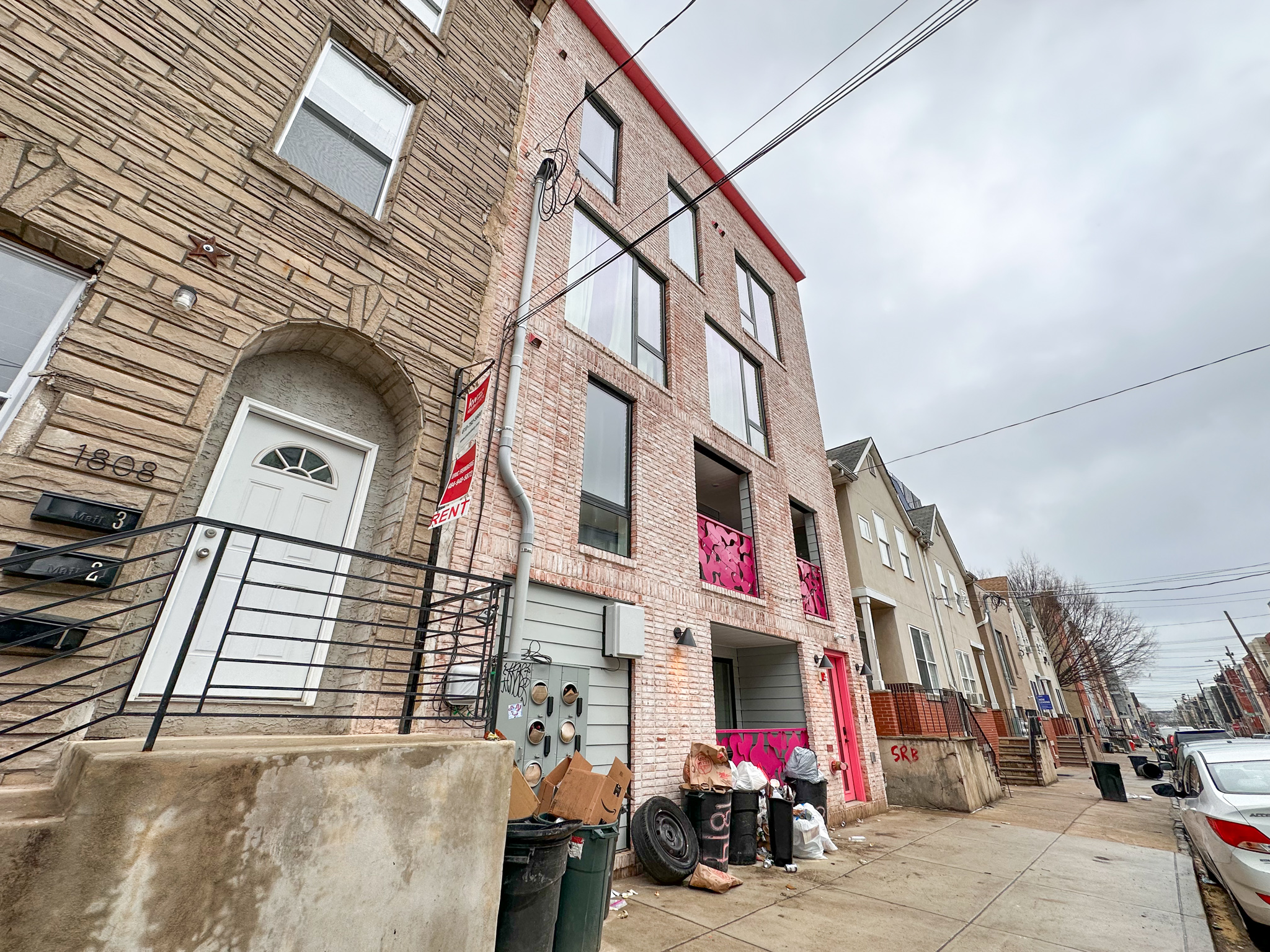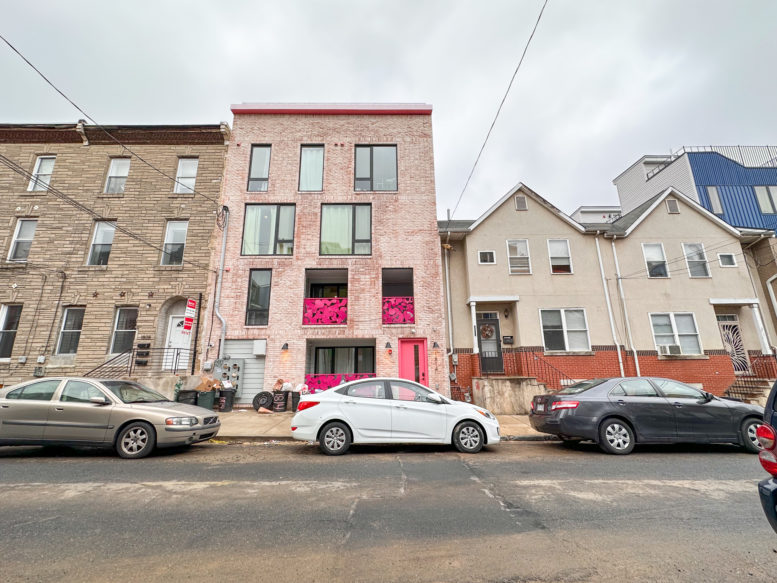A recent site visit by Philadelphia YIMBY has revealed that construction work is nearly complete at 1814 North 18th Street in the Cecil B. Moore neighborhood of North Philadelphia near Temple University. The building sits near the corner of North 18th Street and West Montgomery Avenue. The site is located on the west side of the block between West Montgomery Avenue and West Berks Street.
The new development replaces a three-story suburban-styled residential structure, showing a return to form to the neighborhood’s traditional aesthetic. The site is located within a five-minute walk of the Temple campus and a ten-minute walk to the Cecil B. Moore station on the Broad Street Line.

Aerial view of 1814 North 18th Street. Credit: Google.

Current view of 1814 North 18th Street. Credit: Google.

1814 North 18th Street. March 2023. Photo by Jamie Meller

1814 North 18th Street. March 2023. Photo by Jamie Meller

1814 North 18th Street. March 2023. Photo by Jamie Meller
Fueled by the university’s ever-growing demand for student housing, the neighborhood has seen a continuous development boom over the past twenty years. As the area becomes increasingly built-out, the once-ubiquitous vacant lots and derelict structures are becoming increasingly scarce, so developers are increasingly opting for demolitions of functional structures, such as the one that formerly stood at the site. Fortunately, in this case the building held no notable architectural or historic worth, and the replacement is a definite upgrade. However, to ensure an optimal utilization of local properties in the future, the city ought to consider upzoning this centrally-sited, transit-adjacent area to satisfy the demand for residential space.
Subscribe to YIMBY’s daily e-mail
Follow YIMBYgram for real-time photo updates
Like YIMBY on Facebook
Follow YIMBY’s Twitter for the latest in YIMBYnews


nice building. bleak landscape, between the concrete treeless sidewalks, electrical meters and garbage cans. Philadephia is trying to scare population away?
Philadelphia City government (at least some of it) is trying to attract new residents, especially job creators. At the time of construction, street trees are the developer’s responsibility. Thereafter, it’s on the residents and community who have the opportunity to acquire free trees and pit digging, either from the City or organizations like Pennsylvania Horticultural Society.
Although the City is responsible for trash pickup, that’s not enough to keep a neighborhood clean. Again it’s on the residents to be mindful of securing their trash and keeping their property and surroundings litter free. The trashcans pictured are overflowing with trash and some of it has spilled onto the sidewalk. Ripping up the cardboard boxes would allow for less overflow and less litter. The pictured auto tire is not going to be picked by PHL’s sanitation department. However, tires can legally be disposed (for free) at any number of sanitation convenience centers. In fact, via the ‘Tire Round-up Program’, community groups are paid for each illegally discarded tire brought in.
Philadelphia requires electric meters to be outside and “accessible” but allows for camouflage, so that’s on the developer. Note that the electric box already has graffiti (as do the stairs next door), with the “artist” accountable for the vandalism. Also note that two doors south the electric meters are well hidden under the front stairs.
People in philly has the worst taste. Why is this news?
So what are you saying, Mr Oliner: all of these conditions are left from decisions made by the city for one reason or another and the residents just need to accept them to have a viable city?
(I would choose to live in another city rather then live on a street and in a building where the conditions are such that it makes me feel sad everyday. There are better ways to plan for the conditions, and good architects and planners rise ingeneously to figure out solutions or, let’s go fight city hall!! There are better buildings proposed every day. Stop building if this is the best that can be done.
I also “would choose to live in another city rather then live on a street and in a building where the conditions are such that it makes me feel sad everyday.” Residents don’t “need to accept [City decisions] to have a viable city”. In fact, it is the city denizens’ responsibility to care for their sidewalks and yards, as well as maintenance and appearance of their homes. I agree that “[t]here are better ways to plan for the conditions, and good architects and planners rise ingeniously to figure out solutions”.
Recognize that both litter and illegal dumping are primarily”caused” by Philadelphians, not City government. However, the City has made major efforts to tackle each. See for the City’s efforts to hold illegal dumpers accountable via their pocketbooks. See PHL’s multi-pronged ‘Zero Waste and Litter’ plan at combining enforcement, cleaner public spaces, data, behavioral science (yes, behavioral science), communications and engagement.
Re electricity meters, PECO and the City require meters be placed outside so that they’re accessible to PECO employees. Of course, developers can choose to conceal them, as was done at 722-728 S. Broad St. My guess is that whatever the cost of camouflage, sale or rental price puts them ahead.
Re trees, just last month the City released its first-ever strategic plan for its “urban forest”. The 10-year roadmap includes dozens of recommendations around tree planting, maintenance, and preservation, with the goal to reverse a trend of tree loss in the city and a goal to get each neighborhood to 30% tree cover within 30 years. See details at In addition, City Council legislation passed last year expands existing requirements for developers around preserving and planting trees, as well as sets up new fees for developers if they remove trees and don’t replace them. See more at
See
plan at
See details at
See more at
Sorry, the site does not allow internet links but you can easily Google it.
Weird